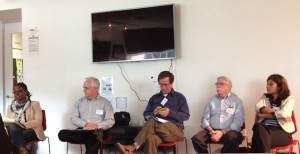High Impact Practices: Experiential Learning
By Jade Ulrich, Pitzer College
On Friday, January 31, 2014, Susie Ferrell and I attended “High Impact Practices: Interdisciplinary collaborations and creative connections,” an experiential learning conference at the University of California, San Diego (UCSD). We presented on a panel entitled “DOCCs: The Dialogues on Feminism and Technology Project” along with Professor Liz Losh (UCSD) and graduate students Monika Sengul-Jones and Erika Cheng (both UCSD). This was Susie and my third time representing FemTechNet at academic conferences; and this conference certainly didn’t disappoint.
Throughout the day attendees had the opportunity to sit in on panels including: Undergraduate Student Research/Education, Experiential Learning Programs at a variety of institutions, Community Partnerships, and Integrating the Arts to Drive Innovation in STEM, among others. It was great to hear from such a wide variety of groups also engaged in experiential learning programs such as FemTechNet.
My favorite part of the day was hearing the keynote presentation by Dr. Mimi Ito of University of California, Irvine. She posed the question: How can learners make the most of today’s abundance of information and social connection? She said the answer lies in stronger connections between in school and out of school learning. Professor Ito shared four highly insightful guiding principles for experiential learning:
- Tap the power of peer-to-peer learning. While the social web can be problematic (especially in the realm of credibility), it can also be hugely beneficial. She listed sites and courses such as StackExchange.com, DS106, #PhoNa and FemTechNet (thanks for the shout-out Mimi!).
- Meet the learners where they are. This point is particularly important for those with interests that are often found on the margins of dominant culture. She mentioned the site Ravelry.com, a community for knitters and crocheters, as an example. Blogs are a great resource for those with something to say, as blogs give them a place to say it.
- Build connected maker spaces. These spaces are hands on studios or computer labs that encourage students to MAKE SOMETHING. It is key that we have places that are tied to technology where kids are building relationships and identities. A successful example of this principle is the YOUmedia Chicago teen learning spaces (check them out here: www.youmediachicago.org).
- Seek recognition in the wider world. Educators can play a huge role in this recognition. The podcast “Library of Games” is an example of this. LoG is a video game journalism program that is open to all high school students “who love video games and want to learn more about games, gaming criticism and journalism.” This podcast is produced by students, for students, but was made possible by an educator that saw a need for this opportunity amongst their students.
This presentation got me thinking about the ways in which FemTechNet is already utilizing these principles. We encourage peer-to-peer teaching and learning, and allow students creative license to do the majority of their projects on areas of interest personal to them. FemTechNet continues to shine as an Experiential Learning success story.

